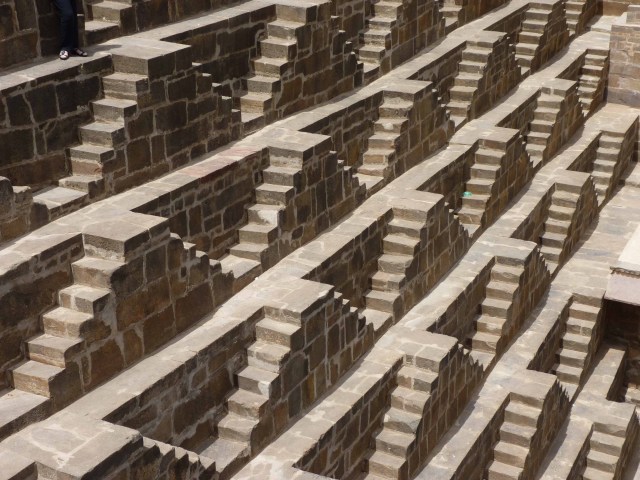So we left Aggra, headed in a westerly direction, onward towards Rajasthan. A transit day for sure but one filled with much to see. Within only an hour or so of leaving Aggra we rolled up at Fatehpur Sikri the great palace city built by Akbar in 1571. The Royal palace was built here as a result of the famous Sufi saint Salim Chishti who had bestowed good news upon Akbar some years earlier. The palace only lasted as the capital for 14 years and was left deserted and ghost like for centuries thereafter.
At its peak it was a splendid mix of Islamic and Hindu architecture with imposing gateways a massive defensive wall plus private and public areas. Same say it was abandoned due to a lack of water, a problem now affecting me in the already sweltering heat of early morning. Like Akbar before me, I too found no water to quench my thirst, the city literally was deserted! No other visitors, no hawkers, no guides, we had it just to ourselves, a highly recommended way of seeing an abandoned ghost city for the full on eery ghostly effect. The ground was dusty the air was dry and the feel of abandonment was almost tangible.
We wandered around in silence soaking up the wonderous architecture all about us. Many of the city’s treasures had been mercilessly plundered over the centuries leaving behind just the shells of these once great marvels of construction, but you could easily sense what a place it had been at its height of power. At this present moment in history though it had been taken over by hordes of monkeys who jumped across the rooftops and played in the courtyards, the new lords of this particular manor.
All too soon we had to leave because the journey ahead was long and arduous with still more to see and experience, so reluctantly we left this fascinating place behind and once more hit the road. India it seems has as many checkpoints on its roads as England has speed cameras on its. Whether these estate border crossings are used to extract bribery from innocent drivers or whether they actually serve a purpose I could not tell, but they punctuate any journey across the northern plains of India with regular monotony.
Eventually in the early afternoon and several above mentioned checkpoints later we deviated from the main thoroughfare and darted off down a dusty road into agricultural land. Off to see a curiously named ‘Stepwell’. What could this Stepwell be, what does the name mean, how is it pronounced? All was revealed as soon as we entered via the tiny gateway and found ourselves staring down into an almost bottomless stone abyss lined with thousands upon thousands of stone steps. Ah…a well with steps, light dawned on my shiny head, simple, it now made sense. This revelation was quickly followed up by an overwhelming feeling of retardedness because it literally was a Step Well, no mystery in the name at all.
Here are the official stats on the well: Chand Baori is a famous stepwell situated in the village Abhaneri near Jaipur in the Indian state of Rajasthan. This step well is located opposite the Harshat Mata Temple and is one of the deepest and largest step wells in India. It was built in the 9th century and has 3500 narrow steps and 13 stories, and is 100 feet deep. Legends say that ghosts built it in one night and that it has so many steps to make it impossible for someone to retrieve a coin once it’s been dropped in the well. Being tight by nature I did not attempt to disprove this theory and kept my money tightly bound in the dark depths of my shorts pocket.
This really was an unexpected treat to see though and all within our party agreed that it was well worth the detour. The skill and ingenuity of the people who built this at a time when in the UK we were literally still living in wooden huts is truly mind-blowing. It was a reminder of how far the ancient cultures of India had progressed while in the west we at the same period in time were still a relative backwater.
Again though and all too soon we had to leave Chand Baori and this amazing feat of engineering behind as we headed ever onward towards Jaipur. Jaipur promised much, The Amber Fort with its elephants, the Pink City itself with its bazaars and historic sights as well as the royal observatory. Of additional intrigue for us was the fact that our residence while in Jaipur would be the opulent Castle Kanota in what was once the old Kingdom of Mewar.
This renovated ex-colonial fort promised much in the way of comfort and luxury and all in our party were eager to sample its many fabled delights. The fort itself was completed in 1876 but never saw battle and instead became the last such fort to be built under the Raj. Recently restored by an ancestor of the original owners the fort was now the first choice of discerning travellers from around the world to Jaipur.

We booked in, collected our room-keys, were suitably impressed by our over generous room, took refreshment on the veranda and readied ourselves for the days ahead; exploring we hoped in and around this jewel of a city deep within Rajasthan.
to be continued ………









